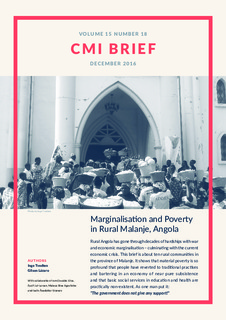| dc.contributor.author | Tvedten, Inge | |
| dc.contributor.author | Lázaro, Gilson | |
| dc.date.accessioned | 2018-01-04T08:22:12Z | |
| dc.date.available | 2018-01-04T08:22:12Z | |
| dc.date.issued | 2016-12-01 | |
| dc.identifier | oai:www.cmi.no:6121 | |
| dc.identifier.citation | Bergen: Chr. Michelsen Institute (CMI Brief vol. 15 no. 18) 4 p. | |
| dc.identifier.issn | 0809-6732 | |
| dc.identifier.uri | http://hdl.handle.net/11250/2475291 | |
| dc.description.abstract | Rural Angola has gone through decades of hardships with war and economic marginalisation – culminating with the current economic crisis. This brief is about ten rural communities in the province of Malanje. It shows that material poverty is so profound that people have reverted to traditional practises and bartering in an economy of near pure subsistence and that basic social services in education and health are practically non-existent. As one man put it:
“The government does not give any support!”
This is a brief from the research project “Cooperation on Research and Development in Angola” between UCAN/CEIC and CMI, and its sub-project “Urban and Rural Poverty Dynamics”. It is based on qualitative/participatory fieldwork carried out in a rural municipality in the Malanje province – with the objective of understanding people’s own perceptions and dynamics of poverty and well-being.
With collaboration from Osvaldo Silva, Eyolf Jul-Larsen, Mateus Bine Agostinho and Iselin Åsedotter Strønen.
Introduction
The province of Malanje and the Municipality of Kalandula is located in the north-east of Angola. Its fame is largely based on having Africa’s second highest waterfall, but as opposed to its equals on the continent there is hardly any economic activity devoted to it. Also the centre of the Municipality and its five rural comunas (see Map) give an immediate impression of economic despair and depression – exemplified by the dearth of commercial outlets, near-empty markets, precarious buildings, poor roads and children in public spaces at mid-day rather than in school. Socio-economic figures testify to a near-impossible situation for the large majority of the 80.000 living in Kalandula – but most people still cope somehow.
Background
In overall terms, rural poverty in Angola is severe. Official statistics testify to a rural poverty rate of | |
| dc.language.iso | eng | |
| dc.publisher | Chr. Michelsen Institute | |
| dc.relation | CMI Brief | |
| dc.relation | 18 | |
| dc.relation.ispartof | CMI Brief | |
| dc.relation.ispartofseries | CMI Brief vol. 15 no. 18 | |
| dc.relation.uri | https://www.cmi.no/publications/6121-marginalisation-and-poverty-in-rural-malanje | |
| dc.subject | Poverty | |
| dc.subject | Rural | |
| dc.subject | Economic Crisis | |
| dc.subject | Education | |
| dc.subject | Health | |
| dc.subject | Malanje | |
| dc.subject | Angola | |
| dc.title | Marginalisation and Poverty in Rural Malanje, Angola | |
| dc.type | Report | |
